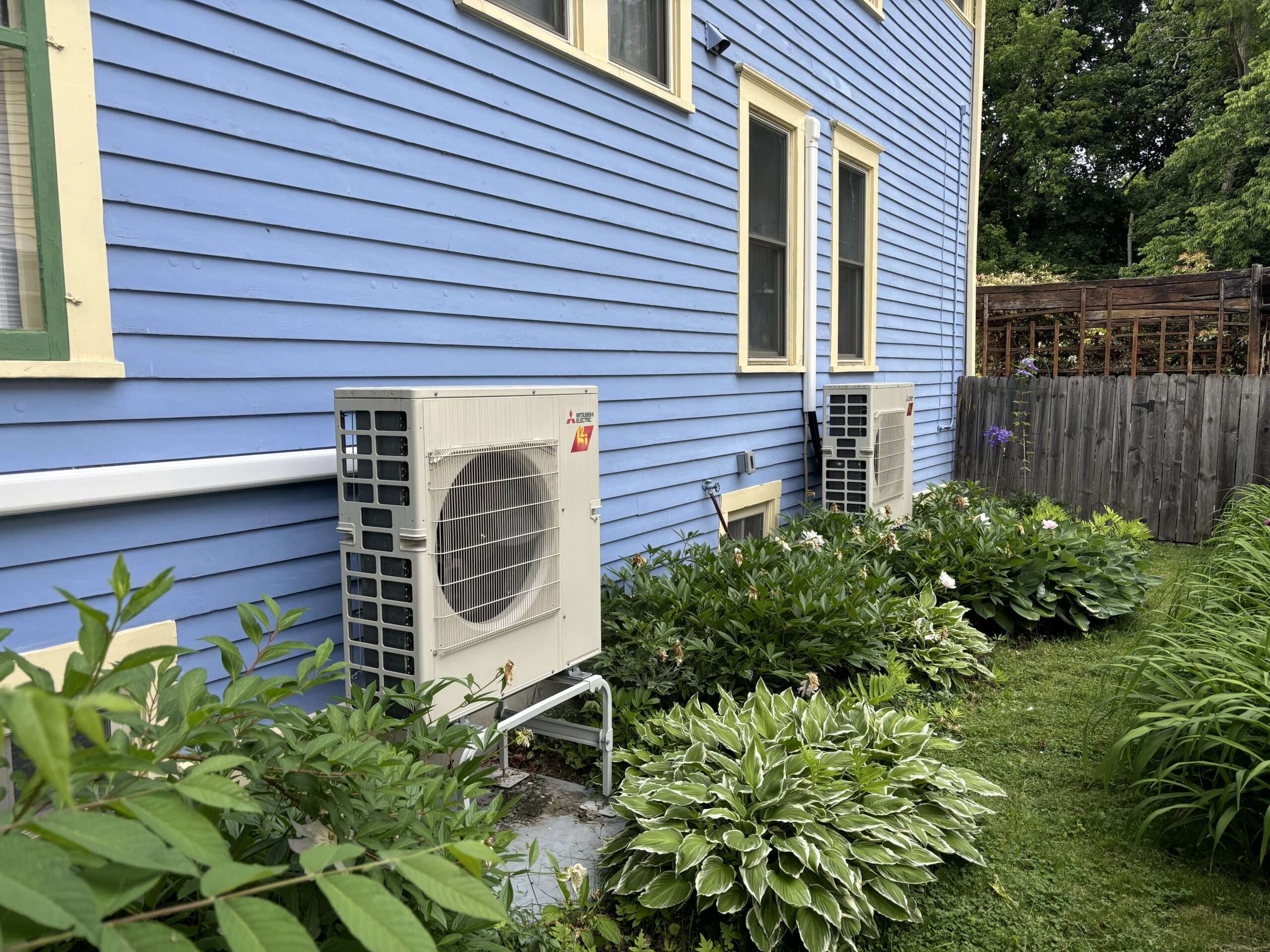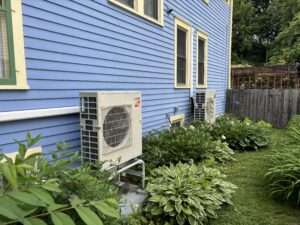I joined PSD in 2009 because I wanted to make a difference in the world and PSD’s mission to make buildings more energy-efficient was very appealing. After we bought our home in 2010, a 100-year-old, 1700 square foot craftsman in downtown Ithaca, NY, our focus for the first 10 years was making functional improvements to the home for me, my wife, and our three children. I was proud of the fact that the previous owner had an energy audit done, sealed and insulated everything, as well as installed a high-efficiency boiler. It didn’t seem that there was much we needed to do. The concept of installing a heat pump wasn’t something we even contemplated since we had a hydronic distribution and very, cold winters.
In 2019 PSD started the planning for the NYSERDA Comfort Home Program, and I became aware that cold climate mini-split ductless heat pumps were a real thing. As our boiler was reaching its end of life, my wife and I started seriously discussing replacing the boiler with heat pumps. While I work at PSD and have an obvious interest in this type of work, it was my wife who was pushing to get this done.
Our motivation was to both reduce our carbon footprint and to have healthier indoor air quality (My wife and kids all have asthma). We had a gas stove (I loved cooking with gas), but we previously invested in a powerful vent to ensure reasonable air quality when running the gas stove. We made a matrix of the combustion systems and appliances in our house and ranked the cost versus the impact on climate change.
While replacing our heating system was the most impactful on carbon savings, it was also far and away the most expensive. The timing for replacing the boiler was for the most part driven by the age of the boiler (it was about 15 years old at that point) and the increasing level of repairs needed to keep it working. Knowing that we needed to do something soon and not wanting to commit to another combustion system, we decided to go ahead and get heat pumps. We expected to reduce our carbon footprint, improve air quality, improve comfort (the hot water baseboard system created rooms that were very hot and very cold), and hopefully reduce our utility bill. We achieved the first three, while the fourth has been more of a challenge.
Once we had decided to install heat pumps, we then had to figure out how to proceed. Given my work at PSD, I roughly knew the correct way to approach electrification in our home. The first step was to reduce the heating load as much as possible and then size the heat pumps. Hot water and appliances would then follow as we wished. In 2017 we decided to get another energy audit done on our home, so I was fairly confident we had reduced the load sufficiently (more on that later) and moved straight to the heat pump phase.
A friend of ours had heat pumps installed and highly recommended the contractor who did the work, so we reached out to get an estimate. Since we had a side arm water tank off the boiler for hot water, we needed to replace the water heater as well so we decided to install a Heat Pump Water Heater (HPWH) along with the heat pumps. The contractor came out and did a Manual J estimate of the heating load and recommended one outdoor unit with 5 indoor heads, two downstairs and three upstairs (one in each bedroom). That, coupled with the HPWH, was nearly $20,000. We sat on the proposal for a year until we had the funding to proceed.
Given the time since the initial proposal, an updated version was needed to reflect current pricing. Over that year, the pricing went up about $800 due to the increased cost of the HPWH. It would have been higher, but the contractor offered a second proposal with an updated configuration with two outdoor units, one serving two 12k indoor units for the downstairs and one serving three 18k indoor units for the upstairs bedrooms. The advantages of this were threefold: it was cheaper, it was easier to get the equipment, and studies were published showing that mini-splits with multiple indoor heads were less efficient as you added more heads. Once we decided to proceed, it took another 7 months for the equipment to be available and the crew to be scheduled. Upgrading the electrical panel was one of the improvements we made when we originally bought the home so that we could add both two outdoor units and the HPWH.
Most of our mental energy was consumed with the heating and hot water, but a colleague tipped me off that Frigidaire had lowered their price by nearly 50% on certain models of induction stoves. While this did not have the global climate impact of the heating and hot water systems, it probably had more impact on our indoor air quality. So we made the change, had an electrician run a 240V line to the kitchen, and invested in new stainless-steel pots and pans.
It was fascinating to be going through this process at my own home, during the same time that PSD was doing extensive research on how to better model and predict savings from projects like this. Looking back, I wish we had waited two years to do the work. We have learned so much about how to choose the right heat pump for a given house. There are so many little things that no one talks about that make a big difference. The original design of the system was to have an outdoor unit on each side of the home. However, when it came time to install the heat pumps, we discussed with the crew foreman and agreed to put both heat pumps on the same side of our home, one upstairs and one downstairs. That decision was an aesthetic one (we would have had to rip out shrubbery on one side of the house) but it had other consequences. Mainly how to run the heated air to the indoor units on the other side of the house in the most energy-efficient way.
Finally, after a nearly two-year journey, we turned on the heat pumps in January 2023. Even though I knew what to do (set heat pumps to a single setting and don’t touch), I still played with the settings a lot over the first few months, trying to figure out what the optimal setting was. Part of the issue was that on very, cold days, the heat pumps needed more fan speed to distribute the heat throughout the downstairs better. I only came to that conclusion after playing with the temperature and fan settings. It did not help that the remote control came with too many options (including timers to support setbacks which you are not supposed to do with heat pumps). It was hard to break out of the mindset that reducing the temperature or fan speed would reduce energy usage (and the cost). However, our energy bills were much higher than they had been previously and kept going up (part of the cycle of constant fiddling).
By March, my utility bill had nearly doubled. Part of the problem I realized was that our electricity supply cost was high because we had a green energy ESCO. Looking at the source carbon for electricity in Upstate NY, I decided that the local utilities’ source energy was sufficiently low carbon, and we could cancel our ESCO account. This helped a lot with the cost of energy but did not do anything to address the underlying problem – using more energy than I hoped. I say, hope because we did not know how much site energy the heat pumps should have saved. The modeling tools when we were considering heat pumps did not handle cold climate air source heat pumps (ccASHPs) accurately, so no energy model was done before installation.
PSD has now built an energy model that accurately reflects ccASHPs, when I entered the information about our house and compared the model’s predicted usage to the actual usage, it was pretty close. There was a bump-up in actual usage in the 30-50F range due to the heat pump’s short cycling. PSD also has built out a way to assess the relative efficiency of a given cold-climate heat pump to the average of all the cold-climate heat pumps in the NEEP database (which is now over 100,000). When I looked up my heat pump model it was right at the average point. So, we might have saved a little more energy, say 10% of the heating bill, by getting a more effective heat pump for the Ithaca climate.
Some of our other observations were that the height of the indoor heads delivered warm air to the top of each room, and a gradient tended to form. Ceiling fans, set to blow hot air down, made a huge difference. Often, for a very, cold day, I would increase the speed of the ceiling fan and not touch the heat pump settings at all. In addition, removing the boiler and installing the HPWH made the basement very cold, which may have increased the energy usage of the first-floor heat pump. So, we had a contractor come and spray foam the basement walls to seal and insulate. There was an incentive available from NYSERDA that covered 50% of the cost of doing this work. Unfortunately, the timing was such that by the time I had the basement ready for the spray foam (everything needed to be at least two feet from the walls in our jam-packed basement), we were past the peak of the winter season. We will need to wait until the next heating season to know the full impact of the additional insulation. We also switched the HPWH to resistance mode on very, cold days to ensure the basement did not get so bitterly cold and start pulling heat from the first floor, thereby setting up a battle between the first-floor heat pump and the HPWH.
We have had a dehumidifier running year-round to keep down the moisture (and mold). We kept that on even after installing the HPWH. When we first looked at the energy use chart, we realized it was making the HPWH work harder, so I shifted the setting on the dehumidifier to only kick in if the basement got very humid (65% from 35%). Now the dehumidifier barely runs and the basement is still as dry as before and the electric bill ticked downward.
The induction stove has been a mixed experience. It definitely, improved the indoor air quality a lot! The specific model had some drawbacks in that the largest range element is not as big as the etching on the glass top implied. We even had a contractor come out to review because it seemed that something was broken, but no, it was just how it was designed. Not all induction stoves are created equal, so I recommend researching before purchasing.
Removing the baseboard elements from all the rooms had two unexpected impacts. One, the home is old enough that the baseboard was installed after it was built, so removing the baseboard uncovered beautiful wood moldings. The other was that it allowed us to clear out decades of dust, pet hair, and other detritus that had accumulated and was not easy to reach when cleaning. Unexpectedly, this had the most dramatic impact on subjective indoor air quality. The heat pump air filters, which are easy to clean and maintain, also help.
Having Emporia monitors helped put things in perspective. I named the Emporia monitor George, as in George Orwell since it was watching everything we did. It helped monitor the impact of each change in real time so that we could fine-tune our approach.
You can see that our car charger was the second biggest consumer of electricity behind the first-floor heat pump. My wife commutes 400 miles a week. If we had to pay for gas for the car, that would cost about $200/month or close to $1000 for the first five months of this year. On the other hand, 33% of our electric bill comes out to just under $700. It is clear we are using less energy than we were, however natural gas piped to our home was cheap, and so on a cost basis, it can be hard to see that.
Throughout this article, I have mentioned the cost of the equipment, but I did want to highlight some of the incentives that we were able to take advantage of to mitigate some of the cost. Living in New York, we participated in several incentive programs offered by our electric utility, and NYSERDA. In addition, we applied for tax credits of $300 in 2022 when we purchased the equipment and $2,000 in 2023 when we paid for the equipment installation (Thank you IRA).
Overall, we are glad we made the leap. The impact on air quality has been the chief benefit to date, but the heat pumps provide plenty of heat even on the coldest days. Also, we now, have air conditioning throughout the house without having to futz with putting in and taking out room ACs. And the heat pumps are all whisper quiet. We know that gas is only going to get more expensive, in the meantime, we are looking into solar – either community farms or panels on our roof. This summer we will replace the gas clothes dryer and then we can completely cut the gas service to the house.
If you enjoyed this article, you can view the recording of the follow up webinar on PSD’s YouTube page. In that presentation I go over the more technical aspects of the upgrades that were made to my home, as well as the efficiency results of having the new equipment in place.





